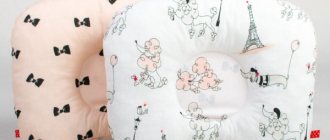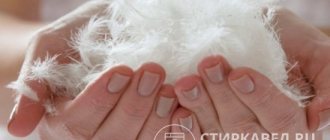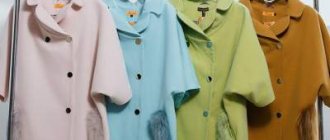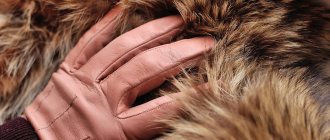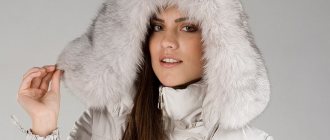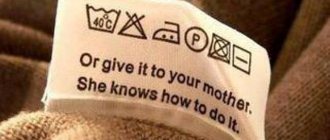Pillows are used constantly - and this cannot but affect their appearance and condition. They may change shape somewhat, dust may accumulate in them, and the cover may become stained. That is why it is important to regularly and promptly care for your bedding. Dry cleaning remains the ideal solution for them, but not everyone has the time or opportunity to systematically send the bed for special treatment. That is why the question of whether pillows can be washed in a washing machine remains relevant for many housewives. In fact, home care is possible - just choose the means and method, taking into account the composition of the model.
Can pillows be washed in a washing machine?
The possibility of using a washing machine to care for pillows depends on the filling of the bedding. Washing is acceptable for the following models:
- Feathers. Washing down pillows has remained a popular cleaning option for decades.
- With wool. Despite the fact that such a pillow will take a long time to dry after washing, this method of care is effective and does not harm the natural filling.
- With holofiber and padding polyester. Polyester-based fibers do not absorb moisture and effectively wick away moisture - and therefore are easy to clean and dry quickly.
- With anti-stress filler. Models with small silicone beads are often considered decorative and are not recommended to be washed. However, if the pillow is very dirty, you can return it to cleanliness in the washing machine - provided all precautions are taken.
- Bamboo. Products with covers made of natural plant fibers can easily withstand wet cleaning and washing - they are completely safe for such material and at the same time make it easy to restore the freshness and volume of the filling.
It turns out that bamboo is the optimal material in terms of price-comfort-ease of care. Think about this even at the stage of purchasing a pillow and choose suitable models. One of these is
Natura Sanat Mint Antistress for 1875 RUR. In the corner of the pillow there is a pocket for a sachet with mint (included in the set). Before washing this model, you need to remove the sachet from the pocket and wash the entire pillow without removing the pillowcase.
However, not just any bedding item can be put into the drum: there are items that absolutely cannot be washed. Thus, washing pillows with the following filling options is prohibited:
- Orthopedic foams and memory foams. When exposed to water, such compounds absorb moisture and lose their anatomical properties. It is no longer possible to restore them after this: they completely lose their elasticity and shape. Fortunately, the materials do not need to be washed—the pillow can simply be vacuumed.
- Cotton wool. When washed, cotton filling clumps into uneven lumps, and it is almost impossible to dry it.
- Natural plant fillers. Buckwheat, herbs, flax seeds and berry seeds - pillows with this composition categorically do not accept this method of care: their contents swell and crumble, and the beneficial properties are lost.
There are the most myths about pillows made of memory (shape memory foam) - they are expensive and difficult to care for. In fact, caring for a memory pen is even easier than caring for a pen—you only need to take care of the filler itself and wash the cover in the washing machine. Many memory models, for example Rayton Cynthia, cost less than 2,000 rubles.
Daily care
How to properly care for your pillow in order to delay washing and dry cleaning:
- change your pillowcase approximately once every seven days;
- Before doing this, beat the pillow thoroughly or vacuum it;
- a new pillow, which is regularly beaten out and pillowcases are often changed, may only need washing after a year;
- if you stain it with blood, urine, coffee, juice, if it smells unpleasant, if there are sloppy stains and stains on the bedside, you will have to take urgent measures.
Yes, if you have such a pillow, washing is inevitable.
General features and washing rules
Regardless of the materials used to fill pillows, washing bedding is subject to general rules that allow you to restore products carefully, safely and without losing their performance properties.
- Choosing a washing method. The pillows can be washed either whole or disassembled. In the second case, rip the pillowcase along the seam on one side, take out the filling, then put it in a washing bag and put it in the washing machine separately from the pillowcase. After thorough drying, the product is put back together. This method takes time and effort, but as a result the pillow looks like new.
- Gentle mode. The maximum temperature for washing bedding is 40 degrees, and it is advisable to select a delicate wash mode and use appropriate detergents - for wool, silk, and delicate fabrics.
- Proper drying. After washing, the pillows are placed strictly on a horizontal surface, periodically turned over and shaken, and after complete drying, they are thoroughly beaten.
Before washing, you should also study the label on the pillow, which contains recommendations for caring for the product.
Choosing a detergent
Pillows should only be washed with liquid textile detergents. As a last resort, you can dissolve the powder in water and pour the soap solution into the washing machine (basin, bathtub).
IMPORTANT : powder detergents are difficult to rinse out of the filler. Its microparticles will remain in the fluff or padding polyester, and you will inhale chemical fumes while you sleep.
How to wash different types of fillings?
You can determine how to wash pillows in a washing machine based on the properties and type of filler. Depending on the contents, the washing mode and further procedures for caring for the pillow are determined.
Down and feather
Products with such filling can be refreshed in the washing machine no more than 1-2 times a year. A down pillow can be washed as a whole or disassembled, but in both cases it is advisable to follow certain rules:
- Wash at a temperature no higher than 40 degrees, at minimum speed, but with a maximum number of rinses.
- Do not use powder as the granules are difficult to wash out. The optimal solution is washing gels or capsules.
- It is advisable to put a tennis ball or special balls into the drum along with the pillow or filling - they evenly beat the fluff and feathers, preventing it from clumping and caking.
- The pillow must be dried strictly horizontally and for as long as possible - preferably in the open sun. At the same time, it must be constantly beaten and shaken to avoid lumps that have not dried out - otherwise the filler will begin to mold.
Wool
Pillows filled with sheep and camel wool require regular washing as they accumulate dust and moisture. Caring for them is quite simple: they can easily be washed in a machine on the appropriate mode using detergents for woolen products. They require careful drying, like any other models with a natural composition.
Bamboo
Bamboo pillows can be washed using both methods, but manufacturers still recommend cleaning the filling separately - this way it will dry faster and better. The best option is to wash the fiber in parts, dry thoroughly, combine and beat properly.
Requirements for washing bamboo pillows are a delicate cycle (“Wool”, “Silk”, “Delicates”), a minimum number of revolutions and an additional rinse to remove residual detergent. Using liquid detergents - gels and capsules for wool, silk and cashmere - will help maintain the volume and airiness of the filler.
Sintepon and holofiber
Polyester fibers are quite unpretentious; manufacturers allow home care for pillows with such filling. By following all the recommendations, you can maintain the volume and properties of the product throughout the entire period of operation:
- Wash on the delicate cycle with the spin cycle turned off. The last condition is mandatory - the filler squeezed out in the drum loses volume and forms lumps.
- It is possible to wash the filling separately from the napkin. Hollofiber and synthetic winterizer dry quickly, and if you comb them with a special brush for fur and wool, they quickly restore elasticity and airiness.
- It is advisable to use liquid detergents to avoid the accumulation of washing powder granules in the fibers of the filler.
- After washing, it is recommended to carefully squeeze out the filler by hand and spread it on a horizontal surface in a dry room for 2-3 days with periodic shaking and beating.
Antistress
Pillows with silicone balls serve a decorative function and are rarely used for sleeping. However, from time to time they also require cleaning and care. Manufacturers advise washing them at home only in exceptional cases - on the most delicate cycle, without spinning or machine drying.
The easiest way is to shake out the filler and put only that in the machine - just rinse the balls in a soapy solution.
Spin and quick dry
When caring for your sleepwear, it's not just washing that's important. To ensure that the bedding does not lose its properties, you must comply with the conditions of spinning and proper drying:
- Pillows with natural feathers and/or down should be spun at low speeds to prevent the material from being compressed or damaged. The optimal option is 400-600 rpm. You need to dry the pillows quickly so that the contents do not start to rot. If the item was washed without removing the filling, it can be put in a dryer; in the summer, it can be placed on a balcony or window sill. To speed up drying, shake and turn over every 20-30 minutes to prevent the feather from getting tangled. The filling that was washed in the bags must be removed and spread out in a thin layer. Cover with gauze to prevent it from flying around. Toss every 15-20 minutes to dry faster.
- It is not recommended to spin wool products at high speeds to avoid damaging the hairs. The recommended speed is a maximum of 500 rpm, but it is better to turn off the spin, put it on a wire rack, and let the water drain. Dry in a horizontal position, shaking occasionally.
- Bamboo pillows do not tolerate spinning well, so it is better to turn it off or slow it down to 400-600 rpm. Then you need to take out the pillow, fluff it up and put it on a flat surface to dry. Knead the filler every 20-30 minutes to prevent it from compacting.
- It is better not to wring out pillows with padding polyester, holofiber and other synthetic fillings. Remove from the tank, use your palms to expel the water, and place in a ventilated place. The possibility of drying in a machine should be checked on the label.
- Products with artificial swan down can be pressed at low speeds. Automatic drying is prohibited. After washing, let the water drain and place the pillow on an absorbent backing.
Reference! It is extremely undesirable to speed up drying with a hot hairdryer or iron, as you can ruin the structure of the fibers of the filler.
Leather
This material cannot be washed. Use spot wet cleaning. Dampen a microfiber cloth with soapy water and wipe any dirty or scuffed areas. Particularly dirty areas should be wiped with a cotton pad soaked in vodka. Wipe with a damp cloth. Rub the surface with Vaseline or rich cream to make the skin glowing and elastic.
In bright areas, use leather-colored shoe polish or coffee grounds. Apply coffee and let it dry. Then shake and wipe with a damp cloth.
How to Hand Wash Cotton and Down Pillows
Yes, these pillows can be washed by hand. Moreover, by hand washing there is less chance of the down in the pillow getting tangled.
Here are some important rules for hand washing pillows
- Water temperature is room temperature (no more than 30 degrees Celsius).
- It is better to wash in a large container, for example, a large basin or bathtub.
- Pour water.
- Now the pillow should be ripped apart so that all its contents can be soaked.
- The filler (fluff) should be soaked for about 3-4 hours.
- Collect all the fluff and squeeze it out. A colander will help you with this.
- All fluff should be carefully placed in small bags in which it will then be dried.
- Now place the bags on a white cloth, preferably a towel (it absorbs moisture well) and leave them to dry. Try to change sides of the bags regularly to ensure everything dries evenly.
- All of the above points are suitable for bamboo and anti-stress pillows.
How to wash bamboo pillows
How to wash anti-stress pillows
Drying after washing
The second important stage of washing is drying.
A wet product is subject to deformation. Pillows should only be dried in a horizontal position.
- Bedding made of synthetic materials is usually dried on or next to a radiator (exceptions are latex and foam).
- Natural fillers should dry naturally: outdoors or in a ventilated area.
Separately, it is worth mentioning the drying of wool and feather pillows. They are placed in the sun on a lattice plane and turned over from time to time, breaking down the fluff and feathers with your fingers (with a carpet beater). If the weather is damp and cold, the products are dried on a radiator. Otherwise they may become moldy.
Basic rules and tips
To extend the service life of pillows with any type of filler, you must adhere to simple rules for operating such products:
- every morning, getting out of bed, the pillow must be fluffed so that by the evening it completely restores its shape;
- to remove dust accumulated in the pillow using a vacuum cleaner or knocking it out 1-2 times a month, and refresh the product by ventilating it in the fresh air - once every two months;
- For long-term storage of such products, you should use bags made of thick fabric rather than polyethylene.
Let's prepare the pillow filling
In fact, proper cleaning is easy and can be done at home. If the down pillow is small and will fit into the drum, you can wash it entirely in the machine by putting on an additional pad. If the product is too large, you will have to rip apart the material, take out the filler and “scroll” it in two or three passes.
So, first you need to cut the napkin and place the down feather in a dry basin. Next you need to take fabric bags; regular pillowcases will do. Put some stuffing in them and sew up the homemade bedsteads well. Be sure to check the tightness of the seam; it must be strong so that the bag does not tear and fluff does not fill the drum of the washing machine, otherwise this will lead to dire consequences.
Next, each of the “new” pillows is washed; it is better to throw 2-3 bags into the machine at once. It is recommended to place special balls or tennis balls into the drum, which will “beat” the filler in the process. There is no need to compact the fluff - the looser it is before cleaning, the better.
How to dry properly
It is equally important to properly dry the filler. Otherwise, poorly dried pillows may acquire an unpleasant odor due to the onset of rotting or mold. In preventing such an unpleasant prospect, the sun and fresh air will come to our aid where we need to place the washed product.
We hang the feather pillow by the corner and turn it over every couple of hours. It is recommended to dry holofiber pillows by laying them horizontally. We also turn them over from time to time, and the filling should be thoroughly beaten. The duration of drying is determined by the size of the product and the filler; it is better to take your time to achieve quality.
Washing pillows for various purposes
At home, you need to wash pillows taking into account their shape, dimensions, filling, and degree of contamination. Figure out what filler is in your things so as not to spoil them:
- incorrectly selected detergent (for example, with active chlorine);
- water temperature is too high;
- harsh mechanical impact, squeezing;
- drying in direct sunlight, on a radiator, in a suspended state.
Washing an orthopedic pillow
An orthopedic pillow ensures the correct position of the head, neck, collar area, uniform load, and comfortable sleep. They should be washed according to the manufacturer's instructions. Natural latex and viscoplastic polyurethane foam require special care and cannot be washed. Read label directions before washing. Do you want your expensive pillow to last a long time? Follow the manufacturer's recommendations.
Washing a pillow for a pregnant woman
A pillow for a pregnant woman is a multifunctional product for sleeping and relaxing. She:
- harmonize the physical condition of the expectant mother by creating special comfort as the tummy increases;
- distribute the load on the spine, facilitate pregnancy;
- After the baby is born, they also become a convenient place for feeding.
Use removable pillowcases to make your pillow less dirty. They use synthetic padding polyester, holofiber, swan's down as filler, that is, predominantly synthetic fibers. Suitable for them:
- hand, machine wash;
- in a liquid product for synthetics;
- at temperatures up to 40 degrees;
- with enhanced rinsing and gentle spinning.
IMPORTANT : a large pillow can become too heavy when wet and damage the washing machine.
Washing a nursing pillow
Pillows serve several functions. The durable case is filled with synthetic filler. It should be hypoallergenic, hygroscopic, with excellent thermoregulation. Lightness, elasticity, softness, beauty and cleanliness are the main requirements for this type of bedding. They should be washed in 30 degree water with liquid detergent without bleach.
When purchasing, check the weight of the pillow when wet so as not to break the washing machine. Find out from the manager whether it is worth washing it at home in a household machine. Maybe it’s easier to take it to the laundry or dry cleaner?
Standard washing recommendations:
- mild liquid fabric care product;
- water 30 degrees C;
- delicate programs, “synthetic”, up to 800 rpm;
- no machine drying.
Is it possible to wash soft toys?
To care for soft toys, several methods are used to clean them:
- handwash;
- machine washable;
- dry cleaning;
- wet cleaning;
- freezing.
Washing is most often used, considering this method to be the simplest, less troublesome and effective. You can wash children's toys, but you should make sure of the following:
- there are no glued parts that can come off during washing;
- the weight is insignificant, this must be taken into account, since very large and heavy samples absorb a lot of water;
- there are no blocks for batteries and other electromechanical parts;
- the item is made of synthetic materials; products made from natural fibers are quite rare; when washed, they shrink and become deformed;
- Stuffing using artificial fibers is used; animals stuffed with sawdust, fluff, cotton wool, and feathers cannot be washed.
Thus, machine washing can be used to clean medium-sized soft toys made of synthetic materials without glued parts and electromechanical units.
On the label of each product, the manufacturer indicates the composition of the materials used for production and recommendations for care. Felt bunnies and bears can only be washed by hand.
But large toys, which are difficult to place in the drum of a washing machine, are better to be dry cleaned. They can be washed by hand. But in this case, the giant toys are difficult to wring out and dry.
Dust mites live in upholstered furniture and interior items
A long drying process does not provide a guaranteed result. There is a high risk that the filler will lock in; getting rid of the smell of dampness and mold will be quite difficult.
